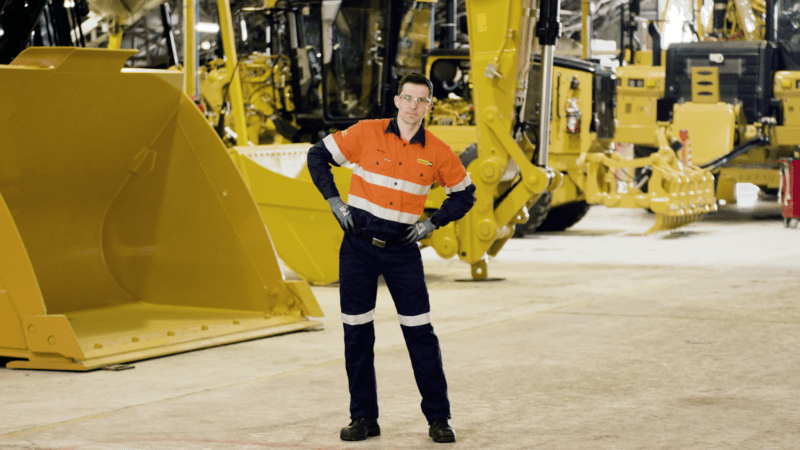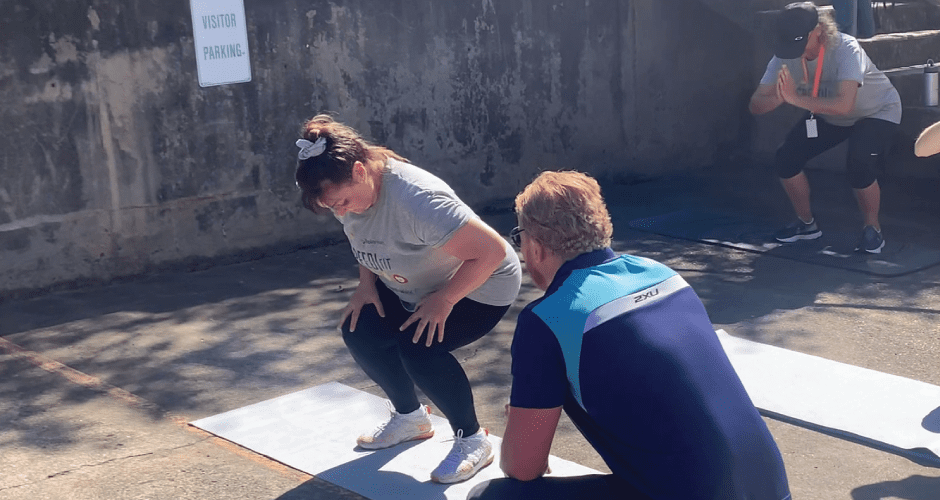It is the teams’ final ritual in their preparation on game day, and they never miss this important ritual to get their head and body ready for the game. Physical work and the workplace is no different, we need to adequately prepare and warm up our minds and bodies before we perform for the day.

What is Dynamic Stretching
Think of a golfer completing practice swings, or a soccer player kicking their leg back and forth, these are examples of dynamic movements. Dynamic warm up and stretching exercises involve a movement component, where joints and muscles are moving into various positions and ranges of motion. This increases muscle activation and blood flow around the body, as well as increasing nerve activity, in turn preparing the mind and body for the tasks ahead.
Dynamic stretching should not be confused with long-hold static stretches, which although are helpful for increasing flexibility, should be completed after activity, rather than beforehand.
Benefits Of Dynamic Stretching For Your Business
Reduce MSD
Implementing a dynamic warm up and stretch program is a proactive step in reducing musculoskeletal disorders (MSDs) within the workplace.
Reduce Injury
Completing the program pre-shift and regularly after breaks can help reduce the risk of injury (particularly soft tissue injuries) to employees, especially in the early stages of a shift or after a break.
Reduce Pain
Research has shown that workers who participate in warm up programs report reductions in pain and disability, as well as increases in endurance and flexibility
ArticleAdvantages Of An Employee Stretching Program For Your Team
Prevent Musculoskeletal Injury
Employees can utilise a dynamic warm up and stretching program as part of their overall health and wellness routine to help prevent their risk of musculoskeletal injury within the workplace
Encouragement
Being active regularly within the workplace provides employees with encouragement to be proactive in their own health and injury risk, as well as feeling supported by the workplace in doing so
Positive Culture
Completing an active warm up routine in a group setting assists in setting a positive health culture within the workplace.
What Does A Workplace Stretching Program Include?
An important aspect of a dynamic warm and stretching program is ensuring it is specific to the workplace and therefore the type of work. We want to ensure that the specific body areas that are under the most strain and exertion throughout the day, and have previously been represented in injury data, are adequately warmed up for the work. In developing a program for your workplace, Employ Health will:
- Complete appropriate analysis to determine appropriate exercise inclusion
- Develop adjunct instructional material (including posters and company-specific video content)
- Complete face to face training sessions
Why Employ Health?
Employ Health’s team of physiotherapists are experienced in assisting workplaces with the development and implementation of dynamic warm up and stretch programs. They understand the importance and effectiveness of the prevention of workplace MSDs, and that dynamic warm ups are an essential aspect of this. Through treatment of common workplace injuries, our physiotherapists have a deep understanding of their affect, and importantly the specific exercises that can be utilised to prevent these.
Employ Health utilises best-in-class technology to develop the content required for a successful dynamic warm up and stretch program within the workplace, including tailored videography. This ensures that programs are specific to your business, rather than the common ‘cookie-cutter’ approach.
Frequently Asked Questions
Dynamic stretches involves controlled, repeated movements of specific body areas, in turn creating successive shortening and lengthening of muscles and increasing blood flow. Static stretching involves stretches where you hold a particular joint position for an extended period of time, usually for longer than 30 seconds.
Dynamic stretching is important prior to activity, to improve muscle activation, blood flow, neural activity and to increase alertness.
Not completing a dynamic warm up prior to physical work could risk acute injury risk, and increase the potential risks associated with fatigue.
Dynamic stretching involves the movement of joints and muscles through their full range of motion, therefore increasing flexibility.
Other important benefits of dynamic stretching is increased blood flow and temperature, as well as increasing muscle strength and power in the subsequent activity.
Static stretching definitely has its place and its benefits. Like dynamic stretching, static stretching has been shown to increase flexibility and range of motion.
However, static stretching should be completed at the end of an activity, once it has been completed, to assist with recovery. Research has shown that static stretching prior to activity does not improve performance and may in fact increase injury risk.
